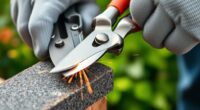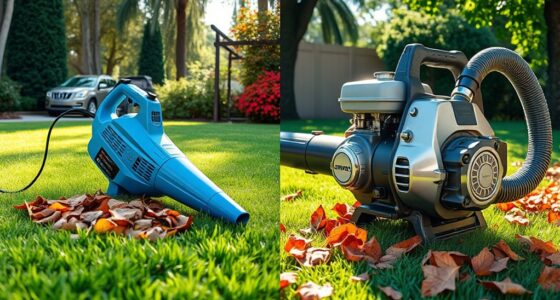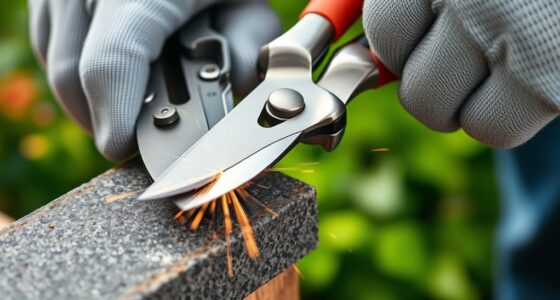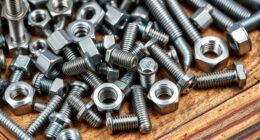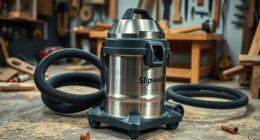To maintain your lawn mower as a beginner, start by checking and changing the oil regularly, and replacing the air filter to keep the engine running smoothly. Sharpen or swap out dull blades, inspect the spark plug, and clean underneath the deck to prevent clogs. Don’t forget to drain old fuel and lubricate moving parts. Proper storage in the off-season helps prolong its life. Keep these tips in mind, and you’ll guarantee your mower stays in top shape.
Key Takeaways
- Regularly check and replace the oil, air filter, and spark plug to keep the engine running smoothly.
- Keep blades sharp and clean the deck to ensure efficient cutting and prevent rust.
- Use fresh fuel and properly store the mower during off-season to avoid engine issues.
- Lubricate moving parts like wheels and drive mechanisms to reduce wear and prolong mower lifespan.
- Perform routine inspections and cleaning to maintain optimal performance and prevent costly repairs.
Checking and Replacing the Oil
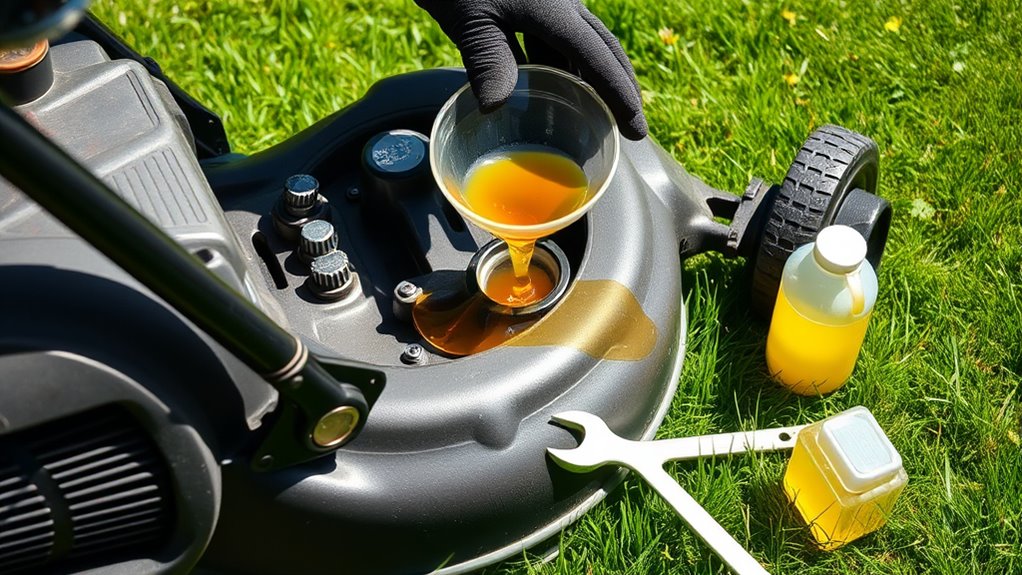
Regularly checking and replacing the oil is essential to keep your lawn mower running smoothly. Start by inspecting the oil levels before each use; if the oil is low, top it off with the recommended type. When checking, wipe the dipstick clean, then reinsert it to get an accurate reading. If the oil appears dirty or gritty, it’s time for a change. Replacing the oil involves draining the old oil completely and refilling with fresh oil. Don’t forget to check the oil filter; a clogged filter can reduce engine performance. Replace the oil filter according to your mower’s manual to ensure proper filtration. Proper oil maintenance prevents engine wear, overheating, and costly repairs, keeping your mower in top shape for every yard job. Additionally, understanding the latest breakthroughs in machine learning tech can help in developing smarter tools for lawn care automation.
Cleaning and Replacing the Air Filter

To keep your lawn mower running smoothly, you need to regularly check and replace the air filter. Start by removing the old filter carefully, making sure not to let dirt fall inside the engine. Then, install a new filter, ensuring it’s seated properly for ideal airflow and performance. Ensuring proper air quality is essential for maintaining the longevity and efficiency of your mower.
Removing the Air Filter
Have you ever wondered why your lawn mower isn’t performing as well as it should? The first step is removing the air filter. Depending on your mower, you’ll encounter different air filter types, such as foam, paper, or cloth. To remove it, locate the air filter cover, usually on the side of the engine, and carefully unclip or unscrew it. Gently pull out the filter, paying attention to its orientation. Be mindful of the air filter materials; foam filters are flexible, while paper filters are fragile. Handle the filter carefully to avoid tearing or damaging it. Proper maintenance of the air filter can prevent ineffective purification and help your mower run smoothly and efficiently. This step prepares you for cleaning or replacing the filter, ensuring your mower runs smoothly and efficiently.
Installing a New Filter
Once you’ve removed the old air filter, it’s time to install a new one to keep your mower running efficiently. Proper filter installation is vital for effective filter maintenance and ensuring your engine breathes properly. Carefully place the new filter into the air filter housing, making sure it fits snugly and securely. Avoid forcing it, as a loose fit can allow dirt to bypass the filter. Check that the filter is properly aligned and seated flat against the housing. Regular filter maintenance, including timely replacement, helps prevent debris from entering the engine, boosting performance and longevity. Using a high-quality airless paint sprayer can also improve your painting efficiency and finish. After installing the new filter, double-check that the cover is securely fastened. Consistent filter maintenance keeps your mower running smoothly and reduces the risk of costly repairs down the line.
Sharpening or Replacing the Blades
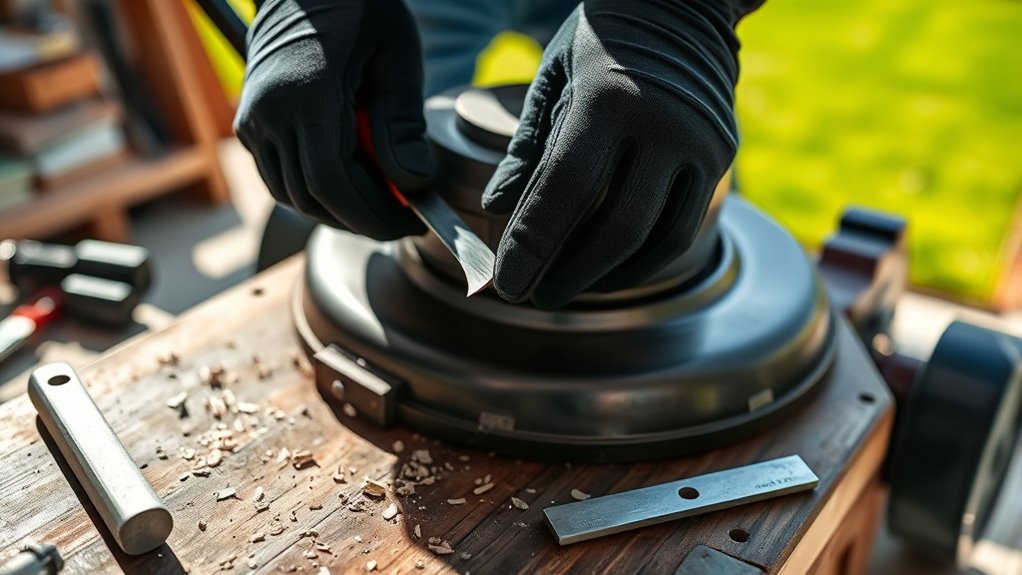
When your lawn mower isn’t cutting as cleanly as it used to, it’s time to assess the blades. Dull or damaged blades hinder blade care and can tear grass instead of cutting it smoothly. Start by removing the blades carefully and inspecting them for nicks, dents, or corrosion. If they’re just dull, sharpening techniques can restore their effectiveness; use a file or grinder to create a sharp, even edge. Be sure to wear gloves and follow safety precautions. If the blades are severely damaged or warped, replacing them is the best option. Sharp blades improve cutting quality and help maintain a healthy lawn. Regular blade maintenance ensures your mower performs efficiently and prolongs its lifespan. Remember, well-maintained blades are key to a lush, neat yard.
Inspecting and Replacing the Spark Plug
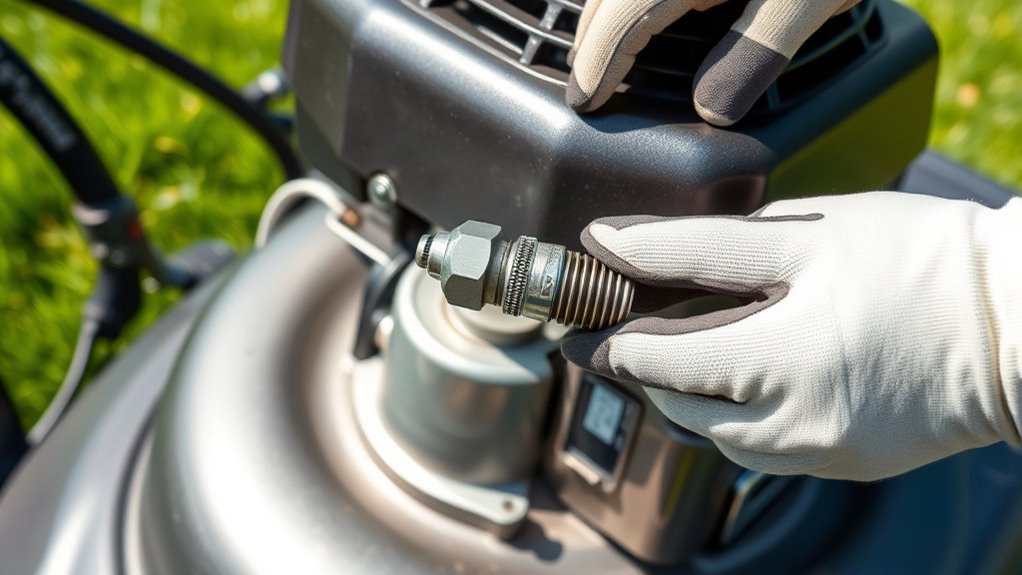
Regularly inspecting your lawn mower’s spark plug is essential to guarantee reliable starts and ideal engine performance. A clean, properly gapped spark plug ensures proper firing and keeps the ignition system working smoothly. To check it, remove the plug using a socket wrench, and examine the electrode for signs of wear, carbon build-up, or damage. If the spark plug looks fouled or worn out, replace it with a new one suitable for your mower. When installing the new plug, verify it’s properly gapped for correct firing. Use the table below to understand common spark plug issues and solutions:
| Issue | Solution |
|---|---|
| Fouled or carbon deposits | Clean or replace the spark plug |
| Worn electrodes | Replace with a new spark plug |
| Incorrect gap | Gently adjust to manufacturer specs |
Additionally, consulting spark plug maintenance guidelines can help maintain optimal engine performance.
Clearing the Underdeck and Mowing Deck
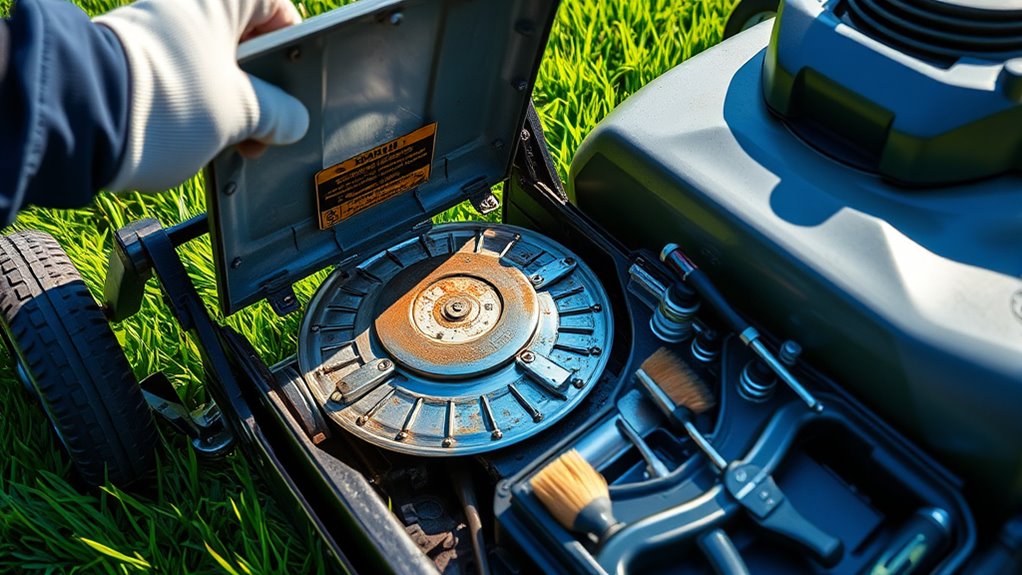
To keep your mower performing at its best, it’s important to clear debris from the underdeck and mowing deck regularly. Deck cleaning prevents buildup of grass clippings, dirt, and debris that can hinder airflow and mowing efficiency. Start by disconnecting the spark plug for safety, then tilt your mower onto its side with the carburetor and air filter facing up. Use a scraper or stiff brush to remove caked-on grass and dirt from the underdeck. Make sure to thoroughly clear the entire area, paying special attention to any clogged discharge openings. Regular underdeck clearing helps maintain proper airflow and prevents rust or corrosion. Additionally, understanding the importance of proper maintenance can help extend the life of your mower and improve its performance. After cleaning, wipe down the deck and reassemble your mower, ensuring it’s ready for peak performance.
Inspecting the Wheels and Adjusting Height
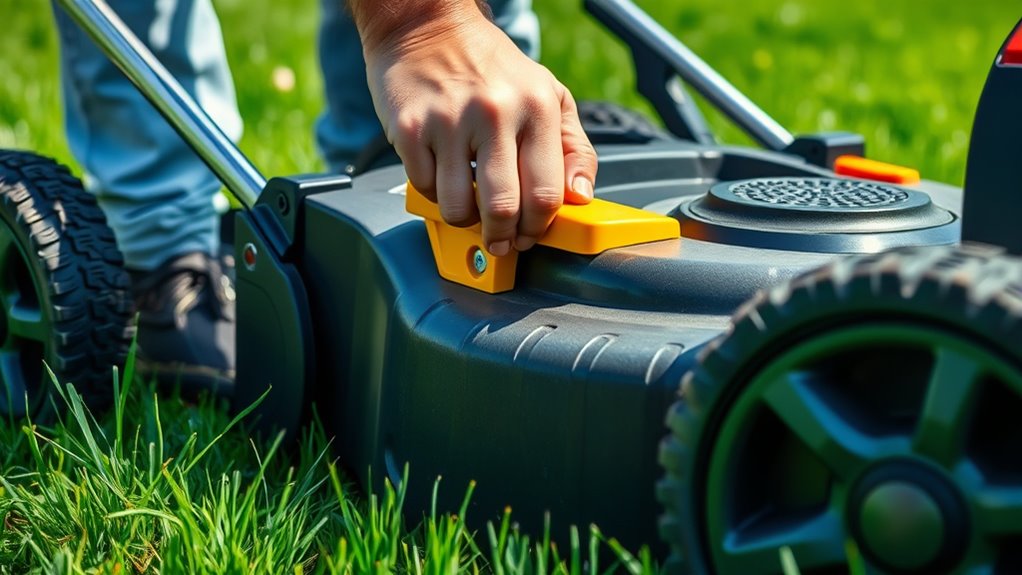
Inspecting your mower’s wheels and adjusting their height guarantees a clean, even cut and prolongs the equipment’s lifespan. Start by checking the tire pressure; proper pressure guarantees wheel alignment and smooth operation. Next, examine the wheels for any damage or uneven wear. If needed, realign the wheels to maintain consistent contact with the ground. Adjust the cutting height using the deck levers to match your preferred grass length. Use the table below to verify settings and adjustments:
| Wheel Side | Recommended Tire Pressure | Adjustment Method |
|---|---|---|
| Front | 20-25 PSI | Turn adjustment screws |
| Rear | 20-25 PSI | Use height levers |
| Overall | Ensure equal pressure | Realign wheels if needed |
Additionally, understanding industry trends can help you stay informed about best practices for mower maintenance.
Draining and Replacing the Fuel
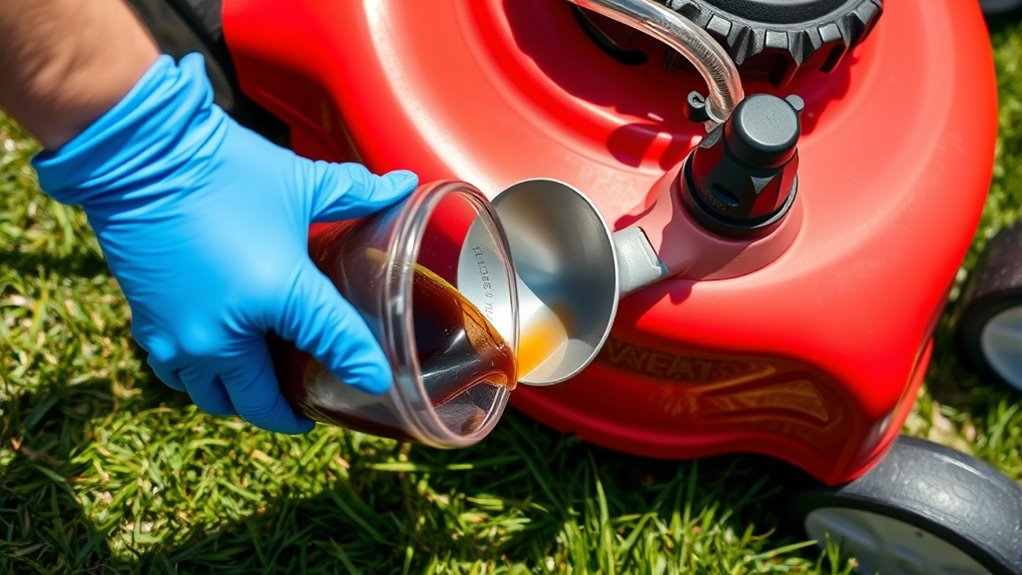
Over time, old or contaminated fuel can cause your mower to run poorly or fail to start. To prevent this, it’s essential to drain the old fuel from your tank. Use a siphon or a pump to remove the fuel safely into a fuel storage container. If you’re storing fuel for an extended period, add a fuel stabilizer to keep it fresh and prevent gumming. Once drained, clean the tank if necessary, then refill it with fresh, stabilized fuel. Always use proper storage containers designed for gasoline to avoid leaks or spills. Regularly replacing your fuel guarantees smooth engine performance and extends the life of your mower. Proper maintenance now will save you headaches later. Incorporating fuel quality considerations into your routine can further enhance engine longevity and reliability.
Lubricating Moving Parts
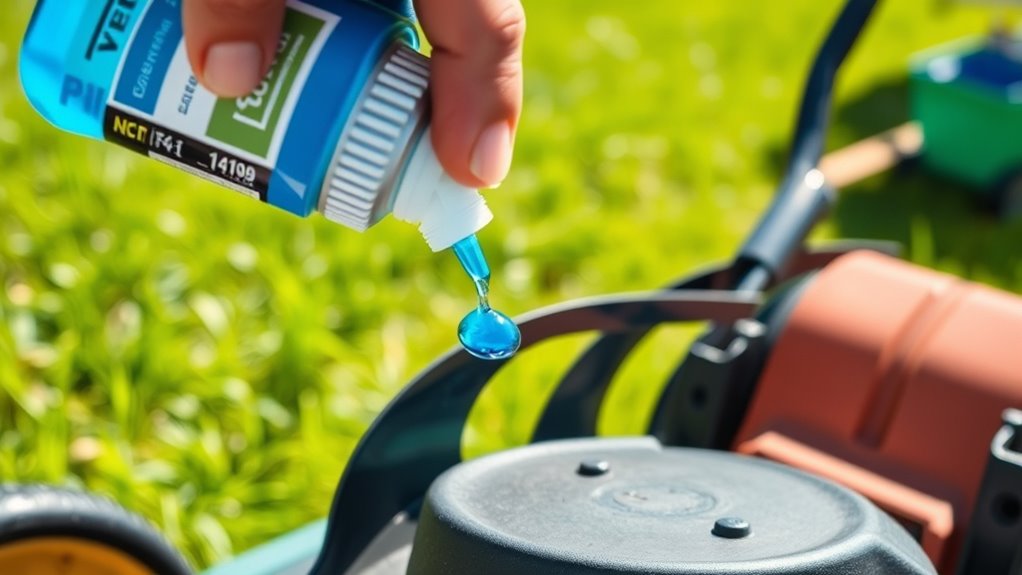
Since moving parts on your lawn mower are constantly in motion, lubrication is essential to keep everything running smoothly. You should regularly check the lube points, such as the wheel bearings and drive mechanisms, to guarantee they stay well-lubricated. Using the right oil type, like mower oil or lightweight machine oil, helps prevent wear and reduces friction. Keep an eye on the oil levels, topping them up as needed to avoid damage caused by low oil. Apply lubricant directly to the lube points, avoiding excess that could attract dirt. Proper lubrication reduces corrosion, minimizes noise, and extends the lifespan of your mower. Regular maintenance of these moving parts keeps your mower operating efficiently and saves you from costly repairs later. Additionally, understanding Ford Tuning concepts can help you appreciate how precise adjustments improve overall performance and longevity of mechanical systems.
Storing Your Mower Properly During Off-Season
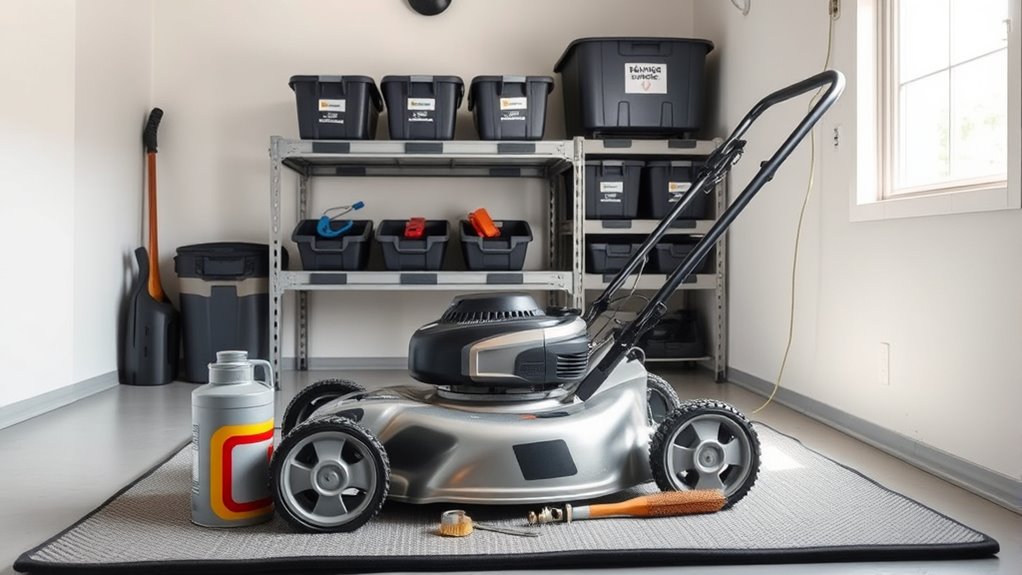
Properly storing your mower during the off-season guarantees it remains in good condition and ready to use when needed. To prepare for seasonal storage, start by cleaning your mower thoroughly to prevent rust and buildup. Next, perform a final check to ensure all parts are lubricated and functioning correctly. Finally, choose an appropriate garden storage area that keeps your mower dry and protected from the elements. Consider these steps for effective seasonal preparation:
- Clean and inspect the mower, removing dirt and debris.
- Drain or stabilize fuel to prevent clogs and corrosion.
- Store in a dry, sheltered space, such as a shed or garage, to avoid exposure to moisture.
Proper storage preserves your mower’s longevity and ensures it’s ready for the next mowing season.
Frequently Asked Questions
How Often Should I Perform Each Maintenance Task?
You should sharpen your lawn mower blade at least once a season or when you notice uneven cuts. Change the oil after every 25-50 hours of mowing or at the start of each season to keep your engine running smoothly. Regular maintenance like blade sharpening and oil changing guarantees your mower performs efficiently and lasts longer. Stay consistent with these tasks, and you’ll enjoy a healthier, well-manicured lawn all year round.
What Safety Precautions Are Necessary During Mower Maintenance?
Think of mower maintenance as a dance — safety is your partner. Always wear protective gear like gloves and goggles to shield yourself from sharp blades and debris. Approach the mower with care, ensuring it’s off and disconnected before handling parts. Use safe handling techniques to avoid injuries. By respecting these precautions, you’ll keep the rhythm steady and your maintenance session smooth and safe.
Can I Perform Maintenance Without Professional Tools?
You can perform basic maintenance with garage tools and DIY tips, but it depends on the task. For simple tasks like cleaning or checking the oil, common household tools often suffice. However, for more complex repairs, specialized professional tools might be necessary for safety and effectiveness. Always assess the job, follow safety precautions, and if unsure, consult a professional. Proper tools guarantee your mower stays in top shape and your safety stays intact.
How Do I Identify When Parts Need Replacing?
Think of your mower like a trusted steed; it shows signs when it’s tired. You’ll notice dull blades needing sharpening, which makes cutting uneven, and oil levels dropping, causing engine strain. Regularly check these parts visually, listen for unusual sounds, or feel for decreased performance. If blades are rusted or chipped, or oil is dark or low, it’s time to replace or top up. Stay attentive, and your mower will serve you well.
What Are Common Signs of Mower Malfunction?
You’ll notice your mower isn’t working properly when it struggles to cut grass evenly or leaves uncut patches. Unusual sounds, excessive vibration, or smoke are signs of malfunction. If your cuts become rough, consider blade sharpening. Also, check if the oil looks dirty or low, which means you need an oil change. Regular maintenance like sharpening blades and changing oil helps prevent malfunctions and keeps your mower running smoothly.
Conclusion
By properly maintaining your mower, you’re nurturing a tool that, like a trusted garden friend, will serve you season after season. Think of each task as tending to a essential branch—skipping one can weaken the whole tree. When you care for your mower, you’re not just ensuring a lush lawn, but cultivating a lasting bond with your outdoor companion. Keep up the good work, and let your yard flourish as a symbol of your dedication.

